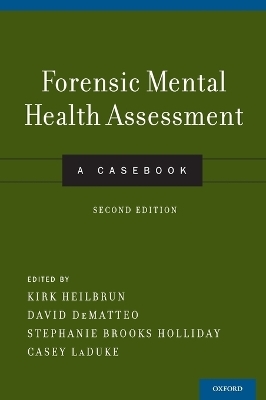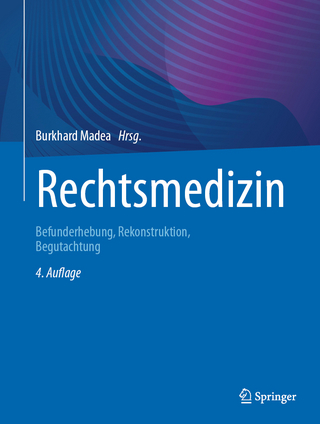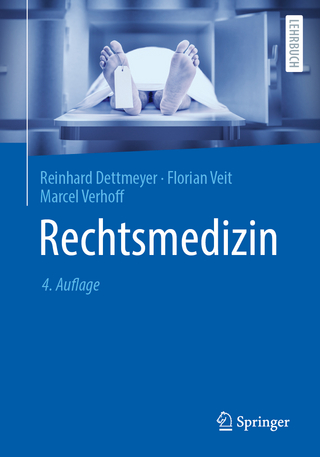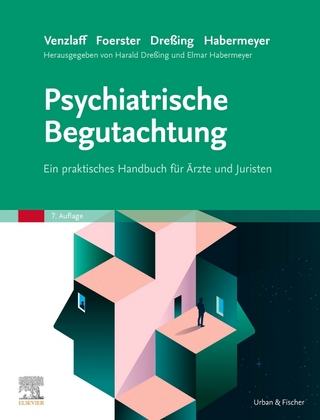
Forensic Mental Health Assessment
Oxford University Press Inc (Verlag)
978-0-19-994155-1 (ISBN)
The Second Edition of Forensic Mental Health Assessment is thoroughly updated in light of the developments and changes in the field, while still keeping the unique structure of presenting cases, detailed reports, and specific teaching points on a wide range of topics. Unlike anything else in the literature, it provides genuine (although disguised) case material, so trainees as well as legal and mental health professionals can review how high-quality forensic evaluation reports are written; it features contributions from leading experts in forensic psychology and psychiatry, providing samples of work in their particular areas of specialization; and it discusses case material in the larger context of broad foundational principles and specific teaching points, making it a valuable resource for teaching, training, and continuing education. Now featuring 50 real-world cases, this new edition covers topics including criminal responsibility, sexual offending risk evaluation, federal sentencing, capital sentencing, capacity to consent to treatment, personal injury, harassment and discrimination, guardianship, juvenile commitment, transfer and decertification, response style, expert testimony, evaluations in a military context, and many more. It will be invaluable for anyone involved in assessments for the courts, including psychologists, psychiatrists, social workers, and attorneys, as well as for FMHA courses.
Kirk Heilbrun, PhD, is Professor, Department of Psychology, Drexel University. His current research focuses on juvenile and adult offenders, legal decision-making, forensic evaluation associated with such decision-making, and diversion. He is the author of a number of articles and books in the area of forensic assessment. David DeMatteo, JD, PhD, is an Associate Professor of Psychology and Law at Drexel University, where he is also Director of the JD/PhD Program in Law and Psychology. His research interests include psychopathy, forensic mental health assessments, drug policy, and diversion. He has authored several books and numerous articles on forensic mental health assessment and related topics.
Preface ; About the Editors ; Contributors ; 1 Introduction and Overview ; 2 Miranda Waiver Capacity ; Case 1 ; Principle: Use nomothetic evidence in assessing clinical condition, functional abilities, and causal connection ; case contributed by I. Bruce Frumkin ; Teaching Point: What is the value of specialized forensic assessment instruments in forensic mental health assessment ; contributed by I. Bruce Frumkin ; Case 2 ; Principle: Use case-specific (idiographic) evidence in assessing clinical condition, functional abilities, and causal connection ; case contributed by Alan M. Goldstein ; Teaching Point: What are the limits of specialized Forensic Assessment Instruments? ; contributed by Alan M. Goldstein ; 3 Competence to Stand Trial ; Case 1 ; Principle: Use testing when indicated in assessing response style ; case contributed by Richard Rogers ; Teaching Point: Integrating different sources of response style data ; contributed by Kirk Heilbrun, David DeMatteo, Stephanie Brooks Holliday, and Casey LaDuke ; Case 2 ; Principle: Select the most appropriate model to guide in data gathering, interpretation, and communication ; case contributed by Patricia A. Zapf ; Teaching Point: How can you use a model to structure the way you write the report? ; contributed by Patricia A. Zapf ; Case 3 ; Principle: Attribute information to sources ; case contributed by Samuel Hawes and Mary Alice Conroy ; Teaching Point: Separating and integrating data from different sources through source attribution in analyzing, reasoning about, and communicating FMHA results ; contributed by Kirk Heilbrun, David DeMatteo, Stephanie Brooks Holliday, and Casey LaDuke ; 4 Criminal Responsibility ; Case 1 ; Principle: Be familiar with the relevant legal, ethical, scientific, and practice literatures pertaining to FMHA ; case contributed by Robert M. Wettstein ; Teaching Point: Sources of particularly relevant information from the literature ; contributed by Kirk Heilbrun, David DeMatteo, Stephanie Brooks Holliday, and Casey LaDuke ; Case 2 ; Principle: Attribute information to sources ; case contributed by Kathleen Kemp and Daniel Murrie ; Teaching Point: Line-by-line versus paragraph-level attribution ; contributed by Daniel Murrie ; Case 3 ; Principle: Decline the referral when evaluator impartiality is unlikely ; case contributed by Ira K. Packer ; Teaching Point: Remaining impartial in high visibility cases ; contributed by Kirk Heilbrun, David DeMatteo, Stephanie Brooks Holliday, and Casey LaDuke ; 5 Sexual Offending Risk Evaluation ; Case 1 ; Principle: Provide appropriate notification of purpose and obtain appropriate authorization before beginning ; case contributed by Philip H. Witt ; Teaching Point: Obtaining informed consent in Sexually Violent Predator cases ; contributed by Kirk Heilbrun, David DeMatteo, Stephanie Brooks Holliday, and Casey LaDuke ; 6 Federal Sentencing ; Case 1 ; Principle: Describe findings so that they need change little under cross-examination ; case contributed by Kirk Heilbrun and Stephanie Brooks Holliday ; Teaching Point: Communicating findings to accurately reflect their strength and the evaluator's confidence in them ; contributed by Kirk Heilbrun, David DeMatteo, Stephanie Brooks Holliday, and Casey LaDuke ; Case 2 ; Principle: Use scientific reasoning in assessing the causal connection between clinical condition and functional abilities ; case contributed by David DeMatteo ; Teaching Point: Risk-assessment in sentencing ; contributed by Kirk Heilbrun, David DeMatteo, Stephanie Brooks Holliday, and Casey LaDuke ; 7 Capital Sentencing ; Case 1 ; Principle: Use multiple sources of information for each area being assessed. Review the available background information and actively seek important missing elements ; case contributed by Kirk Heilbrun and Jacey Erickson ; Teaching Point: How much is enough? Diminishing returns from information sources ; contributed by Kirk Heilbrun, David DeMatteo, Stephanie Brooks Holliday, and Casey LaDuke ; Case 2 ; Principle: Obtain relevant historical information ; case contributed by Mark Cunningham ; Teaching Point: Evaluating the accuracy of different sources of third-party information ; contributed by Kirk Heilbrun, David DeMatteo, Stephanie Brooks Holliday, and Casey LaDuke ; 8 Capital Sentencing, Atkins-type Evaluations ; Case 1 ; Principle: Accept referrals only within area of expertise ; case contributed by J. Gregory Olley ; Teaching Point: Gauging the training and experience in forensic and mental health areas needed for this kind of evaluation ; contributed by Kirk Heilbrun, David DeMatteo, Stephanie Brooks Holliday, and Casey LaDuke ; Case 2 ; Principle: Use relevance and reliability (validity) as guides for seeking information and selecting data sources ; case contributed by Karen L. Salekin ; Teaching Point: Selecting tools for use in FMHA ; contributed by Kirk Heilbrun, David DeMatteo, Stephanie Brooks Holliday, and Casey LaDuke ; 9 Competence for Execution ; Case 1 ; Principle: Identify relevant forensic issues ; case contributed by Patricia A. Zapf ; Teaching Point: Identify assessment targets when legal standards are broad or non-specific ; contributed by Patricia A. Zapf ; 10 Capacity to Consent to Treatment ; Case 1 ; Principle: Use third party information in assessing response style ; case contributed by David DeMatteo ; Teaching Point: Balancing results from interview, testing, and third party sources as they relate to response style ; contributed by Kirk Heilbrun, David DeMatteo, Stephanie Brooks Holliday, and Casey LaDuke ; Teaching Point: Communicating complex scientific material to legal professionals and lay audiences ; contributed by Kirk Heilbrun, David DeMatteo, Stephanie Brooks Holliday, and Casey LaDuke ; 11 Testamentary Capacity ; Case 1 ; Principle: Determine whether the individual understands the purpose of the evaluation and associated limits on confidentiality ; case contributed by Eric Drogin ; Teaching Point: Advantages of written versus spoken notification in determining whether the notification is understood ; contributed by Kirk Heilbrun, David DeMatteo, Stephanie Brooks Holliday, and Casey LaDuke ; 12 Personal Injury ; Case 1 ; Principle: Carefully consider whether to answer the ultimate legal question. If answered, it should be in the context of a thorough evaluation clearly describing data and reasoning, and with the clear recognition that this question is in the domain of the legal decision maker ; case contributed by Bill Foote ; Teaching Point: Answering the ultimate legal question directly ; contributed by Kirk Heilbrun, David DeMatteo, Stephanie Brooks Holliday, and Casey LaDuke ; Case 2 ; Principle: Decline the referral when evaluator impartiality is unlikely ; case contributed by Alan M. Goldstein ; Teaching Point: Declining the case when impartiality would be too difficult ; contributed by Alan M. Goldstein ; 13 Civil Commitment ; Case 1 ; Principle: Use relevance and reliability (validity) as guides for seeking information and selecting data sources ; case contributed by Tadeus Edward Kowalski and Douglas Mossman ; Teaching Point: The strengths and weaknesses of classification systems ; contributed by Kirk Heilbrun, David DeMatteo, Stephanie Brooks Holliday, and Casey LaDuke ; 14 Harassment and Discrimination ; Case 1 ; Principle: Do not become adversarial, but present and defend your opinions effectively ; Principle: Write report in sections, according to model and procedures ; case contributed by Bill Foote ; Teaching Point: Communicating firmly but fairly ; contributed by Kirk Heilbrun, David DeMatteo, Stephanie Brooks Holliday, and Casey LaDuke ; Teaching Point: The value of sequential communication of FMHA results ; contributed by Kirk Heilbrun, David DeMatteo, Stephanie Brooks Holliday, and Casey LaDuke ; 15 Workplace Disability ; Case 1 ; Principle: Assess legally relevant behavior ; case contributed by Lisa Drago Piechowski ; Teaching Point: The relationship between symptoms and disability in capacity to work ; contributed by Kirk Heilbrun, David DeMatteo, Stephanie Brooks Holliday, and Casey LaDuke ; Case 2 ; Principle: Assess clinical characteristics in relevant, reliable, and valid ways ; case contributed by Robert L. Sadoff ; Teaching Point: Useful approaches to assessing clinical characteristics in FMHA ; contributed by Kirk Heilbrun, David DeMatteo, Stephanie Brooks Holliday, and Casey LaDuke ; 16 Guardianship ; Case 1 ; Principle: Be aware of the important differences between clinical and forensic domains ; Principle: Be familiar with the relevant legal, ethical, scientific, and practice literatures pertaining to FMHA ; case contributed by Randy K. Otto ; Teaching Point: Guardianship and the revised Specialty Guidelines for Forensic Psychology ; contributed by Randy K. Otto ; 17 Child Custody ; Case 1 ; Principle: Determine the particular role to be played if the referral is accepted ; case contributed by Marsha Hedrick ; Teaching Point: Can one ever play more than one role in a single FMHA case? ; contributed by Kirk Heilbrun, David DeMatteo, Stephanie Brooks Holliday, and Casey LaDuke ; Case 2 ; Principle: Use multiple sources of information for each area being assessed ; case contributed by Jonathan W. Gould ; Teaching Point: The role of the forensic clinician in collecting third party information ; contributed by Kirk Heilbrun, David DeMatteo, Stephanie Brooks Holliday, and Casey LaDuke ; 18 Child Protection ; Case 1 ; Principle: Assess legally relevant behavior ; case contributed by Jennifer Clark and Karen Budd ; Teaching Point: Identifying forensic capacities when the legal standard is vague or unelaborated ; contributed by Kirk Heilbrun, David DeMatteo, Stephanie Brooks Holliday, and Casey LaDuke ; Case 2 ; Principle: Be guided by honesty and striving for impartiality, actively disclosing the limitations on as well as the support for one's opinions ; case contributed by Kathryn Kuehnle and H. D. Kirkpatrick ; Teaching Point: Specific strategies for promoting impartiality in a particular evaluation ; contributed by Kirk Heilbrun, David DeMatteo, Stephanie Brooks Holliday, and Casey LaDuke ; Teaching Point: Mental health professionals' role in assisting the court in determining the veracity of allegations of child sexual abuse ; contributed by Kathryn Kuehnle and H. D. Kirkpatrick ; 19 Juvenile Miranda Waiver Capacity ; Case 1 ; Principle: Use nomothetic evidence in assessing causal connection between clinical condition and functional abilities ; case contributed by I. Bruce Frumkin ; Teaching Point: Applying group-based evidence supporting a specialized forensic assessment measure in a single case ; contributed by I. Bruce Frumkin ; Case 2 ; Principle: Do not become adversarial, but present and defend your opinions effectively ; case contributed by Kirk Heilbrun and Megan Murphy ; Teaching Point: Whether and how to criticize material from the records ; contributed by Kirk Heilbrun, David DeMatteo, Stephanie Brooks Holliday, and Casey LaDuke ; 20 Juvenile Competence to Stand Trial ; Case 1 ; Principle: Use relevance and reliability (validity) as guides for seeking information and selecting data sources ; case contributed by David DeMatteo ; Teaching Point: Selecting a specialized measure on juvenile CST ; contributed by Kirk Heilbrun, David DeMatteo, Stephanie Brooks Holliday, and Casey LaDuke ; Case 2 ; Principle: Ensure that conditions for evaluation are quiet, private, and distraction-free ; case contributed by Janet I. Warren ; Teaching Point: Identifying and implementing strategies for improving inadequate conditions ; contributed by Kirk Heilbrun, David DeMatteo, Stephanie Brooks Holliday, and Casey LaDuke ; 21 Juvenile Commitment ; Case 1 ; Principle: Accept referrals only within area of expertise ; case contributed by David DeMatteo and Heidi Strohmaier ; Teaching Point: What training and experience in forensic, developmental, and mental health areas are needed for juvenile forensic expertise? ; contributed by Dewey G. Cornell ; Case 2 ; Principle: Provide appropriate notification of purpose and obtain appropriate authorization before beginning ; case contributed by Kirk Heilbrun and Lindsey Peterson ; Teaching Point: Obtaining authorization for evaluating minors who cannot yet legally consent ; contributed by Kirk Heilbrun, David DeMatteo, Stephanie Brooks Holliday, and Casey LaDuke ; 22 Transfer and Decertification ; Case 1 ; Principle: Assess legally relevant behavior ; case contributed by Amy L. Wevodau and Mary Alice Conroy ; Teaching Point: Translating legal criteria into forensic capacities ; contributed by Kirk Heilbrun, David DeMatteo, Stephanie Brooks Holliday, and Casey LaDuke ; Case 2 ; Principle: Use third party information in assessing response style ; case contributed by Kirk Heilbrun and Casey LaDuke ; Teaching Point: Addressing conflicting information from the interview, testing, and third party sources ; contributed by Kirk Heilbrun, David DeMatteo, Stephanie Brooks Holliday, and Casey LaDuke ; 23 Military ; Case 1 ; Principle: Identify relevant forensic issues ; case contributed by Michael Sweda and Samantha M. Benesh ; Teaching Point: Forensic issues in this kind of evaluation that is conducted in a military context, and comparability with and distinctions from civilian law ; contributed by Kirk Heilbrun, David DeMatteo, Stephanie Brooks Holliday, and Casey LaDuke ; Case 2 ; Principle: Obtain appropriate authorization ; case contributed by Paul Montalbano ; Teaching Point: How does the evaluator address the question of <"severe mental disease or defect?>" ; contributed by Paul Montalbano ; Teaching Point: Obtaining appropriate authorization in military FMHA, and similarities with and differences from civilian parameters ; contributed by Paul Montalbano ; Case 3 ; Principle: Use nomothetic evidence of clinical condition, functional abilities, and ; causal connection ; case contributed by Eric B. Elbogen ; Teaching Point: Combining nomothetic data with case-specific idiographic information ; contributed by Kirk Heilbrun, David DeMatteo, Stephanie Brooks Holliday, and Casey LaDuke ; 24 Release Decision-Making ; Case 1 ; Principle: Obtain relevant historical information ; case contributed by Chad Brinkley and David Mrad ; Teaching Point: Integrating information from hospitalization and pre-hospitalization in release decision-making ; contributed by Kirk Heilbrun, David DeMatteo, Stephanie Brooks Holliday, and Casey LaDuke ; Case 2 ; Principle: Use multiple sources of information for each area being assessed ; case contributed by Craig R. Lareau ; Teaching Point: Using multiple sources for relevant hospitalization and pre-hospitalization information ; contributed by Kirk Heilbrun, David DeMatteo, Stephanie Brooks Holliday, and Casey LaDuke ; Case 3 ; Principle: Describe findings and limits so that they need change little under cross-examination ; case contributed by Terrance J. Kukor ; Teaching Point: Achieving balance and facilitating accuracy in reporting findings ; contributed by Kirk Heilbrun, David DeMatteo, Stephanie Brooks Holliday, and Casey LaDuke ; 25 Threat/Risk Assessment ; Case 1 ; Principle: Identify relevant forensic issues ; case contributed by Stephen D. Hart and Kelly A. Watt ; Teaching Point: The role of RNR in contemporary threat/risk assessment ; contributed by Kirk Heilbrun, David DeMatteo, Stephanie Brooks Holliday, and Casey LaDuke ; Case 2 ; Principle: Ensure that conditions for evaluation are quiet, private, and distraction-free ; case contributed by Dewey G. Cornell ; Teaching Point: How can threat assessment be distinguished as a form of risk assessment? ; contributed by Dewey G. Cornell ; Case 3 ; Principle: Use nomothetic evidence in assessing clinical condition, functional abilities, and causal connection ; case contributed by Randy K. Otto and Jay Singh ; Teaching Point: Combining nomothetic data with case-specific, idiographic information ; contributed by Kirk Heilbrun, David DeMatteo, Stephanie Brooks Holliday, and Casey LaDuke ; Teaching Point: How can different approaches to risk assessment be used to inform the evaluation and the case outcome? ; contributed by Randy K. Otto ; Case 4 ; Principle: Obtain relevant historical information ; case contributed by Joel A. Dvoskin ; Teaching Point: When specialized measures cannot be used ; contributed by Joel A. Dvoskin ; 26 Response Style ; Case 1 ; Principle: Use testing when indicated in assessing response style ; case contributed by Ashley Kirk Burgett and Richard Frederick ; Teaching Point: Assessing malingering of cognitive deficits using testing ; contributed by Richard Frederick and Ashley Kirk Burgett ; Case 2 ; Principle: Use third party information in assessing response style ; case contributed by Phillip J. Resnick ; Teaching Point: Using records and collateral interviews in assessing response style ; contributed by Kirk Heilbrun, David DeMatteo, Stephanie Brooks Holliday, and Casey LaDuke ; 27 Expert Testimony ; Commentary throughout contributed by Stanley Brodsky ; Case 1 ; Principle: Communicate effectively ; Teaching Point: Moving from "adequate" to "effective" in presenting expert testimony ; contributed by Kirk Heilbrun, David DeMatteo, Stephanie Brooks Holliday, and Casey LaDuke ; Principle: Base testimony on the results of the properly performed forensic mental health assessment ; Teaching Point: Using the report to facilitate expert testimony ; contributed by Kirk Heilbrun, David DeMatteo, Stephanie Brooks Holliday, and Casey LaDuke ; Principle: Control the message. Strive to obtain, retain, and regain control over the meaning and impact of what is presented in expert testimony ; Teaching Point: Strategies for maintaining some control over the message ; contributed by Kirk Heilbrun, David DeMatteo, Stephanie Brooks Holliday, and Casey LaDuke ; case contributed by Kirk Heilbrun and Jacey Erickson ; References ; Index
| Verlagsort | New York |
|---|---|
| Sprache | englisch |
| Maße | 257 x 188 mm |
| Gewicht | 1503 g |
| Themenwelt | Geisteswissenschaften ► Psychologie ► Entwicklungspsychologie |
| Geisteswissenschaften ► Psychologie ► Sozialpsychologie | |
| Geisteswissenschaften ► Psychologie ► Test in der Psychologie | |
| Geisteswissenschaften ► Psychologie ► Verhaltenstherapie | |
| Medizin / Pharmazie ► Medizinische Fachgebiete ► Psychiatrie / Psychotherapie | |
| Studium ► 2. Studienabschnitt (Klinik) ► Rechtsmedizin | |
| ISBN-10 | 0-19-994155-6 / 0199941556 |
| ISBN-13 | 978-0-19-994155-1 / 9780199941551 |
| Zustand | Neuware |
| Haben Sie eine Frage zum Produkt? |
aus dem Bereich


